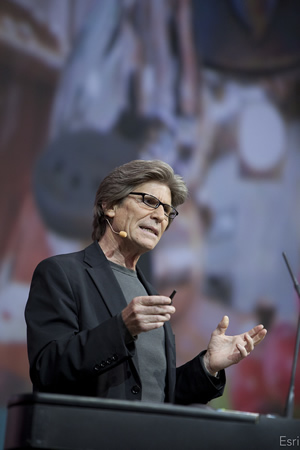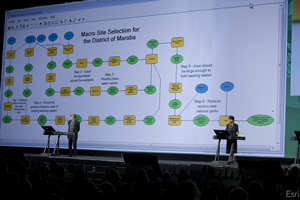ArcWatch: Your e-Magazine for GIS News, Views, and Insights
August 2011
Grounds for Change
GIS Plays Supporting Role in Improving Rwanda's Coffee and Its Growers' Lives

Timothy T. Schilling and Mich�le Adesir-Schilling say that Rwandan coffee is now highly sought after by the specialty coffee market.
The establishment of 200 coffee berry-washing stations in Rwanda over the last decade, sited using GIS technology, has put the East African nation on the specialty coffee map.
With only the best coffee berries—also known as cherries—selected during processing, Starbucks Coffee Co. and other roasting companies now pay premium prices for Rwandan coffee. Rural farmers now reap incomes six times higher than they did a decade ago.
"The most beautiful thing about it is that the income has gone into putting kids into schools, buying school supplies, getting the family health care—basically allowing them to improve their own lives," Timothy T. Schilling, director of the US Agency for International Development (USAID) Rwanda, told the audience at the 2011 Esri International User Conference (Esri UC).
Schilling and his wife, Mich�le Adesir-Schilling, a professor of ecology and GIS at the University of Rwanda, gave a Plenary Session Keynote Address about Rwanda Specialty Coffee, a project USAID supports. Their story underscored the conference theme, Understanding Our World, as it showed how GIS was used to choose the best locations to set up the coffee-washing stations, contributing to the success of the project.
"They are a couple of heroes in my view," Esri president Jack Dangermond said of the Schillings, whom he met on a trip to Rwanda.

Rwandan coffee farmers now earn more money than in the past because the quality of the coffee has improved, Timothy Schilling said.
A Coffee Paradise
Rwanda has 500,000 coffee farms. In 2000, this coffee was not at a quality grade that attracted notice from the world market. "I was living in a veritable coffee paradise. Everything was great—the altitudes, the rainfall, the soils. Everything was perfect, but something was wrong," Schilling said. "This coffee tasted . . . awful."
The Schillings worked to bring individual farmers together and developed a method and standard to raise the quality of their coffee to be one of the world's most outstanding. By raising quality, they raised demand and prices, which in turn raised the economic levels of the country.
What caused farmers to participate? The Schillings worked to get funding to build a coffee berry-washing station that brought the community together in a venue wherein they sorted and selected the best berries to create a quality standard. The coffee industry was enticed by the consistency and flavor of this coffee and purchased it.
The Geography of Coffee Map
The project began to grow, and the Schillings sought to place more berry-washing stations in the surrounding regions. Working with the University of Rwanda, Adesir-Schilling developed a sophisticated geographic model for site analysis. One input was a sensory profile of coffee characteristics, including finish, body, and taste types, much like the wine industry has. These profiles were used to categorize coffee cherries, and then these were linked to the regions that produced them. The next part of the analysis was to determine what variables in those regions might be the cause of the coffee characteristics including soil pH, water, temperature, and elevation. Adesir-Schilling used statistical modeling to isolate growing conditions attributed to coffee characteristics and then located these conditions in the surrounding areas, plotting them on a map. The Geography of Coffee map shows coffee characteristics by region, such as East, North Kivu, and South Kivu. Next, Adesir-Schilling used GIS to perform a proximity analysis to determine the best sites for the berry-washing stations. The Schillings then provided this information to potential investors.

Working with a GIS team from the National University of Rwanda, Adesir-Schilling developed a sophisticated geographic model for analyzing which sites would be most suitable to locate the coffee berry washing stations.
"A washing station immediately raises the quality of the coffee coming from the fields," said Schilling. "[There] we are able to sort, select, and purchase only high-quality cherries."
What do the workers look for in a high-quality berry? "Good, ripe, turgid red cherries," he said.
Part of the program was to educate Rwandans to evaluate the quality of their coffee, so coffee specialists were brought in to train the locals. Farmers adopted new farming practices to produce a high-grade cash crop. Eventually, Starbucks Coffee Co. began to buy coffee directly from Rwanda, and the country's exports took off. The university tracked the success, showing that farmers who followed this coffee model had business returns that grew 82 percent faster than the nonparticipating farms.
The Global Coffee Quality Research Initiative has been launched to extend the Rwandan coffee marketing model to other coffee-producing countries.
The standard of living rose for many Rwandan coffee farmers. The annual income of $500 per year per family in 2000 grew to $3,000 per year in 2010. "Hundreds of thousands of rural Rwanda families are making six times more money today than they did in 2000 through this coffee sector," Schilling said.